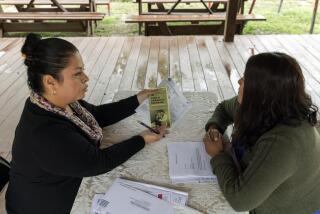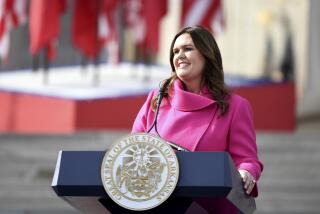Number of Uninsured May Be Overstated, Studies Suggest
- Share via
WASHINGTON — The number of Americans without health insurance -- one of the most watched and worrisome indicators of economic well-being -- may be overstated by as much as 20%, according to research conducted for the government.
That could mean 9 million fewer uninsured, reducing the total to 36 million from the 45 million reported for 2003, the latest year for which data are available.
The over-count appears to stem from technical problems with the Census Bureau’s Current Population Survey, but its implications could have broad consequences for the healthcare debate and for a federal child health program that uses survey data to allocate hundreds of millions of dollars to the states.
Politically, “there would be a lot less interest in dealing with the uninsured if it turned out there weren’t so many,” said Joseph Antos, a health policy analyst with the American Enterprise Institute, a conservative think tank in Washington. “There would be accusations that [the administration] was rigging the numbers to make a serious problem go away.”
Also, a recalibration could shift individual states’ shares of a $5-billion pool of federal funds for providing health insurance to children in low-income families. Officials said the overall dollar amount of the pool would not change, but a state’s share might rise or fall with new estimates of the number of uninsured children in each state. California is allotted $667 million from the program for 2005.
Reflecting the political sensitivity of the issue, the White House said President Bush was determined to expand coverage, regardless of the precise number of uninsured. Democrats have criticized Bush for not doing enough to stanch the loss of employee health benefits.
“The president believes there are too many Americans who are uninsured,” White House spokesman Trent Duffy said. “We defer to the official experts on exactly what the count is, but the president thinks it’s too many.”
Bush favors tax breaks for health savings accounts to make insurance more affordable for the middle class, and government spending on community health centers for low-income people as well as subsidized coverage for their children. But he has proposed Medicaid cuts that critics say could leave thousands of people without coverage.
How quickly critics may pounce on anything suggesting insensitivity on the coverage issue was illustrated by the reaction of a prominent economist. Uwe Reinhardt of Princeton University, a specialist on healthcare issues, said the administration’s decision to commission the research showed that it was worrying more about counting the uninsured than about helping them.
“I call it the body count,” Reinhardt said. “Instead of addressing the problem, we say we must count the uninsured. It is literally, in my view, like making sure we know how many deck chairs we have on the Titanic.”
Nonetheless, Reinhardt said, he agreed that the figure of 45 million might be high.
The push to reassess the number of people lacking health insurance came from Michael O’Grady, a top health economist in the Bush administration. As assistant secretary for planning and evaluation in the Health and Human Services Department, he secured funding for two separate studies and is encouraging government statisticians to work out the discrepancies.
O’Grady said in an interview that his only interest was in making sure lawmakers in Congress and the president had the most accurate numbers possible.
“Nobody is trying to diminish this problem -- this is still a big, serious public health problem,” he said. “We’re trying to give policymakers the best data available so it feeds into a policy development process that reduces the number of uninsured Americans.”
The Census Bureau estimated that 45 million Americans lacked health insurance for all of 2003. But one of the new studies, conducted by Actuarial Research Corp., a private company, estimated that 9 million of the 45 million had coverage.
The other estimate, using 2001 data, was calculated by researchers at the Urban Institute, a nonpartisanWashington think tank. It indicated a smaller over-count of about 4 million.
Both studies concluded that the Current Population Survey overstated the number of uninsured because it undercounted the number of people covered by Medicaid, the federal-state health program for low-income and disabled people.
“People can have their opinions about which [new estimate] is closer to the truth, but clearly this is good research,” said Charles T. Nelson, assistant chief of the Census Bureau division that handles income, poverty and health statistics. “How we turn this research into recalibrating actual survey results is something we have to look at.
“There could be a significant change in the number of uninsured people,” Nelson said. But he said it would take considerable work to refine the survey.
Government economists have suspected problems with the census figure since the Clinton administration, O’Grady said. He said revised estimates might not be available until 2006.
Four government surveys attempt to estimate the number of Americans who are without coverage for a full year, a potentially harmful gap. The results range from a high of 45 million in the Current Population Survey to a low of 19 million in the less-known Survey of Income and Program Participation, also by the Census Bureau.
“How do you go to a president and say, ‘Mr. President, let me explain to you that there’s four different surveys and there might only be 20 million uninsured, or there might be 45 million’?” O’Grady said. “We’re just trying to get to the right number.”
In addition to the disparities among the surveys, statistical reports to Washington from the states also point to a problem, O’Grady said. When individual states report the number of people they actually cover each year through Medicaid, many give totals significantly higher than census estimates.
The Current Population Survey is the estimate relied on most widely. It gathers answers to a detailed questionnaire from about 80,000 households, a statistically huge sample. The results are then extrapolated to the entire U.S. population.
It remains unclear why there would be such a problem with health insurance information. One hypothesis is that the topic of health insurance comes up well into the lengthy questionnaire, and some people may be answering “no” to avoid follow-up questions. Another is that some people may not want to acknowledge that they are on Medicaid.
“There is an undercount of Medicaid coverage,” said Nelson, the census official. “We are looking at ways of improving our estimate so people covered by Medicaid report. There are people with coverage out there who are not reporting coverage.”
A lower estimate of the number of uninsured Americans may provide only a fleeting sense of relief, however. Both groups of outside researchers found that the ranks of the uninsured continue to rise with the erosion of private coverage.
“Whatever method one applies, we’re still going to get rising uninsurance,” said Linda Giannarelli of the Urban Institute. “This problem is not going to go away.”
*
(BEGIN TEXT OF INFOBOX)
Fewer vulnerable?
Two new studies, each looking at a different year, found that the U.S. census overestimated the number of Americans without health insurance.
*--* Uninsured in 2003* (In millions) *--*
*--* Census Current Population Survey -- 45 Actuarial Research Corp. -- 35.9 *--*
*--* Uninsured in 2001* (In millions) *--*
*--* Census Current Population Survey -- 41.2 Urban Institute -- 37.6 *--*
* Estimates are for people uninsured the full calendar year Sources: Actuarial Research Corp., Urban Institute
More to Read
Get the L.A. Times Politics newsletter
Deeply reported insights into legislation, politics and policy from Sacramento, Washington and beyond. In your inbox twice per week.
You may occasionally receive promotional content from the Los Angeles Times.










